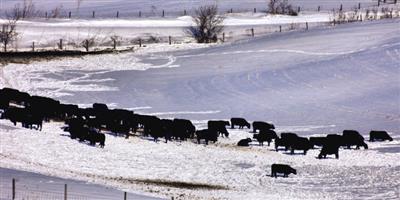Living in the Northern Plains and Rocky Mountain states has its ups and downs. The view sure is pretty with the livestock grazing on the horizon but winter proves to be tough. Winter feeding is a guarantee in Montana, Wyoming, and the Dakota’s but there are options for producers. After speaking with extension cow/calf and beef specialists, there are a variety of feeding options and health considerations for this fall and winter.
Hay:
Hay is always top priority on a rancher’s mind, nearly year-round. Getting enough rain in the spring for the grass to grow, cutting and putting up hay in the summer to provide for the herd, fall counting to make sure there is plenty of hay for the winter, and the winter distribution to the herd. Luckily, most of the region was in fairly good shape for hay compared to last year with the Dakota’s having the best year. If needed, hay in the Dakota’s can be bought in the $70 to $95 per ton range, depending on quality. Montana was in much better situation than last year but those who couldn’t put up hay will be searching in the $125 to $165 per ton range, depending on quality and availability, while Wyoming ranchers had a drier year with reports of alfalfa hay at $140 to $160 per ton. One thing to keep in mind, whether it be your own hay supply or a load trucked in, is to do a feed analysis. Dr. Steve Paisley, University of Wyoming Extension Beef Cattle Specialist, highly recommends a feed analysis on hay bales to find the vitamin, mineral, and energy content. Knowing what the hay lacks in nutrition will be helpful in feeding throughout the winter months.
Energy and Protein Options:
Early to mid-Fall, ranchers can turn cattle out on winter wheat and corn stalks before the snow settles in. These, along with other forages in the field or pasture, can provide a light protein and energy source leading up to winter feeding. Crop byproducts are a great option for providing a protein source to the herd and, depending on the ranch location, can be very cost effective as they can be found in many places and from a variety of crop sources. Wheat mid-lings, DDG’s, and draff (malt distillers) are some of the options available to our region. In areas in South-central Montana, Northern Wyoming, and the East/West boarder of Montana and North Dakota beet pulp can be bought at a low price and used as an energy source. Contracts do need to be made with many of the providers of these processed by-products, NDSU Extension Livestock System Specialist John Dhuyvetter says, so getting in contact with the plants sooner rather than later. This is important because those by-products are shipped out for other uses. Another option that SDSU extension cow/calf field specialist Adele Harty says people have been asking about is soybeans. She says they can make a good protein supplement but making sure there is a feed ration calculated is important because the fat content in soybeans can have a negative effect on the health of the animal. And yet another option, that many producers utilize, are lick tubs and cake. These can provide many of the necessary supplements in solid or liquid form. A feed analysis of hay helps narrow the selection for lick tub supplements but some to consider should provide vitamin A, D, and E in the winter months.
Water:
“A hidden nutrient we don’t think a lot about is water. Making sure those cattle have access to a fresh, clean water source even during the winter months,” MSU Extension Beef Cattle Specialist Dr. Megan Van Emon reminds producers. Water drives intake so Dr. Van Emon says maintaining a water source for the herd will help them eat, digest, and maintain body temperature during the winter months.
Take-aways:
Making sure the herd is getting the energy, protein and other vitamins and minerals is crucial through the winter months. Dr. Paisley says that some people forget about those cows after weaning and hauling the calves off but now is the time to be building body condition. Building that condition for the colder months will take more protein and the third trimester of pregnancy requires more energy to help that calf and cow along. Dr. Van Emon reminds ranchers that having a good water source helps with winter intake and looking at the cost effectiveness of DDG’s and lick tubs could help save a few dollars. And John Dhuyvetter and Adele Harty encourage producers to graze as long as possible to help extended the winter feed supply and take advantage of the native grasses before the snow cover. Contact your local extension beef specialist or local beef nutritionist for more information or to discuss any other options for winter feeding.
###
Sources: MSU, University of Wyoming, NDSU, & SDSU Extension
Dr. Kellen, Nutritionist for Nutra-Lix


